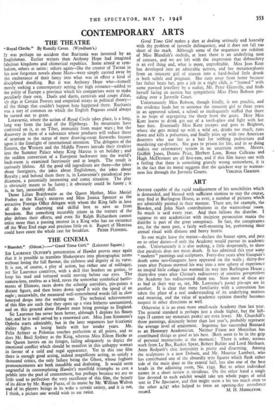ART
ANYONE capable of the rapid readjustment of his sensibilities which is demanded, and blessed with sufficient stamina to stay the course, may find at Burlington House, as ever, a number of pictures which are admirably painted in their manner. There are, for example, the Bawden, and. John Nash contributions in the watercolour room. So much is said every year. And then follows the diatribe. I suppose to any academician with incipient persecution mania the diatribe is part of the great conspiracy. In fact, the conspirators are, for the most part, a fairly well-meaning lot, performing their annual ritual with distaste and heavy hearts.
So one might leave the matter—declare the bazaar open, and pass on to other duties—if only the Academy would pursue its academic ends. Unfortunately it is also seeking, a little desperately, to show that paralysis does not mean death. It has admitted this year some " modern " paintings and sculptures. Forty-five years after Gauguin's death some neo-Gauguins have appeared on the walls ; thirty-five years after Picasso stormed his way into a new sphere of experience an insipid little collage has wormed its way into Burlington House ; thirty-five years after Chiricp's rediscovery of emotive perspectives the Academy has rediscovered them too. Now most of these are as bad in their way as, say, Mr. Lawrence's pastel pin-ups are in another. It is clear that mere familiarity with a convention has taken the place of a real understanding of its underlying motives and meaning, and the value of academic opinion thereby becomes suspect in other directions as well.
Otherwise it is an even more small-scale Academy than last year. The general standard is perhaps just a shade higher, but the hill- tops (I cannot say mountain peaks) are even fewer. Mr. Churchill's three paintings, distinctly better than last year's, probably represent the average level of attainment. Segonzac has succeeded Bonnard as an Honorary Academician. Neither Fitton nor Moynihan has contributed things as good as his best. (Both seem to be in the grip of personal mannerisms at the moment.) There is sober, serious work from Le Bas, Ruskin Spear, Robert Buhler and Lord Methuen. Anne Redpath's chic femininity is pretty and disarming. Among the sculptures is a new Dobson, and Mr. Maurice Lambert, who has contributed one of the absurdly trite figures which flank either side of the main door to the central hall, has also one of the best heads in the adjoining room, No. 1343. But to select individual names in a short review is invidious. On the other hand a single line devoted to each exhibit would take ten whole pages of solid text in The Spectator, and that might seem a bit too much even to the other 4,747 who helped to form an opening-day attendance


































 Previous page
Previous page